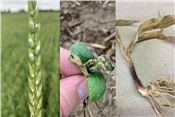|
KY Grain Producers Should Scout Their Fields For Crop Damage

Freeze damage to wheat, soybeans and corn. Corn and soybeans should survive. The damaged wheat spikelets will not.
The healthy spikelets will survive if they do not get a disease.
Wheat and soybean photos by Chad Lee, UK grain crops specialist. Corn photo submitted by Pulaski County farmer.
LEXINGTON, KY.
University of Kentucky grain crops specialists encourage grain growers to scout their fields for freeze and disease damage and determine the next steps for their crops.
On May 8 and 9, temperatures in Kentucky, with the exception of the far west regions, fell below freezing for several hours. This is the second freeze event in three weeks. The first occurred April 15 and 16 across many areas of the state.
If crop damage occurred because of this latest freeze, it should be appearing in fields now and become more evident over the next couple of weeks, said Chad Lee, grain crops specialist in the UK College of Agriculture, Food and Environment. He added that damage has varied in the fields he has scouted thus far, and it is important for producers to scout each of their fields, as there are many factors that could impact the extent of damage.
“Temperatures measured at a weather station height are not the same as temperatures on the soil’s surface and are not the same as 3 feet high, which is where many wheat heads were at the time of the freeze,” said Lee, who is director of the UK Grain and Forage Center of Excellence. “Field elevation is another factor that will affect temperatures. A 10-feet elevation difference in a field may have had a 1 degree difference in temperature, and that 1 degree resulted in damage.”
At the time of both freeze events, much of the area’s wheat was in advanced growth stages, and corn and soybeans were emerging from the ground. Bill Bruening, UK wheat variety testing coordinator, recently observed freeze damage to wheat in Fulton, Christian, Caldwell, Webster, Woodford and Fayette counties. Damage occurred from either the May freeze, the April freeze or both, depending on the location. Lee walked fields in Hardin County, where wheat was damaged from both freeze events.
Not helping matters, cool wet conditions that the state experienced the week beginning May 18 have created a good environment for disease development and slowed plant growth and freeze damage recovery.
“Assessing the extent of freeze damage will be very important to understanding potential yield impacts and also for those wheat producers determining whether a fungicide application to help control infection of Fusarium head blight is needed,” said Carrie Knott, UK grain crops specialist. “If seeds are viable and yield loss is minimal from the freeze, fungicides can help protect yield potential, quality and profitability. If there is no viable seed and a great reduction in yield due to either freeze event, then fungicides may not result in profitable management this year.”
Young corn and soybean plants are also very susceptible to seedling blight diseases, also known as “damping off.” Since they are in earlier growth stages, they are more likely to recover from freeze damage.
“As long as the soybean node at the cotyledons remains and the stem is not split, the plant will most likely survive and will have 100 percent yield potential,” Lee said. “New growth in corn should be evident by now. If not, producers should dig up some plants and examine them from the seed to the soil surface. If it is turgid, it still has a chance for survival. If it is soft and mushy or brown, it is dead.”
Knott has developed videos that show producers how to scout for freeze damage in wheat that was flowering and in grain fill. They are available on the college’s YouTube channel at https://www.youtube.com/watch?v=u0DUgEa23bE and https://www.youtube.com/watch?v=OhcqjeiIE8s&feature=youtu.be. Producers can also visit the grain crops specialists' blog, https://www.kygrains.info/blog/2020/5/18/assessing-wheat-freeze-in-kentucky, to get more in-depth information on how to assess crop damage and to see the kinds of damage the specialists are finding in the fields they are scouting.
Producers can get more information on corn and soybean seedling diseases and fungicide efficacy by visiting the Crop Protection Network’s website at https://cropprotectionnetwork.org/. Those who suspect they have a disease in a grain crop should send samples to their county extension agent, who can get the samples to one of UK’s Plant Disease Diagnostic labs for verification. ∆
|
|